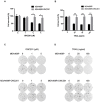ONC201 activates ER stress to inhibit the growth of triple-negative breast cancer cells
- PMID: 28423492
- PMCID: PMC5400611
- DOI: 10.18632/oncotarget.15451
ONC201 activates ER stress to inhibit the growth of triple-negative breast cancer cells
Abstract
ONC201 was previously identified as a first-in-class antitumor agent and small-molecule inducer of the TRAIL (tumor necrosis factor-related apoptosis-inducing ligand) gene that induces apoptosis in cancer cells. ONC201 has a safety profile and is currently in phase II clinical trials for the treatment of various malignancies. In the current study, we examine the effect of ONC201 on triple-negative breast cancer cells (TNBC), a subtype of breast cancer that is sensitive to TRAIL. We find that ONC201 inhibits the growth of TNBC cells including TNBC cells that have developed acquired TRAIL resistance. However, TNBC cells that have developed acquired ONC201 resistance are cross-resistant to TRAIL. Mechanistically, ONC201 triggers an integrated stress response (ISR) involving the activation of the transcription factor ATF4. Knockdown of ATF4 impairs ONC201-induced apoptosis of TNBC cells. Importantly, the activation of ATF4 is compromised in ONC201-resistant TNBC cells. Thus, our results indicate that ONC201 induces an ISR to cause TNBC cell death and suggest that TNBC patients may benefit from ONC201-based therapies.
Keywords: ATF4; ONC201; TRAIL; apoptosis; triple-negative breast cancer.
Conflict of interest statement
No potential conflicts of interest were disclosed.
Figures






Similar articles
-
ONC201 Demonstrates Antitumor Effects in Both Triple-Negative and Non-Triple-Negative Breast Cancers through TRAIL-Dependent and TRAIL-Independent Mechanisms.Mol Cancer Ther. 2017 Jul;16(7):1290-1298. doi: 10.1158/1535-7163.MCT-17-0121. Epub 2017 Apr 19. Mol Cancer Ther. 2017. PMID: 28424227 Free PMC article.
-
Small-Molecule ONC201/TIC10 Targets Chemotherapy-Resistant Colorectal Cancer Stem-like Cells in an Akt/Foxo3a/TRAIL-Dependent Manner.Cancer Res. 2015 Apr 1;75(7):1423-32. doi: 10.1158/0008-5472.CAN-13-3451. Epub 2015 Feb 20. Cancer Res. 2015. PMID: 25712124 Free PMC article.
-
ONC201 kills solid tumor cells by triggering an integrated stress response dependent on ATF4 activation by specific eIF2α kinases.Sci Signal. 2016 Feb 16;9(415):ra18. doi: 10.1126/scisignal.aac4374. Sci Signal. 2016. PMID: 26884600 Free PMC article.
-
Discovery and clinical introduction of first-in-class imipridone ONC201.Oncotarget. 2016 Nov 8;7(45):74380-74392. doi: 10.18632/oncotarget.11814. Oncotarget. 2016. PMID: 27602582 Free PMC article. Review.
-
ONC201 and imipridones: Anti-cancer compounds with clinical efficacy.Neoplasia. 2020 Dec;22(12):725-744. doi: 10.1016/j.neo.2020.09.005. Epub 2020 Oct 23. Neoplasia. 2020. PMID: 33142238 Free PMC article. Review.
Cited by
-
Targeting mitochondrial respiration for the treatment of acute myeloid leukemia.Biochem Pharmacol. 2020 Dec;182:114253. doi: 10.1016/j.bcp.2020.114253. Epub 2020 Oct 2. Biochem Pharmacol. 2020. PMID: 33011159 Free PMC article. Review.
-
Targeting multiple signaling pathways: the new approach to acute myeloid leukemia therapy.Signal Transduct Target Ther. 2020 Dec 18;5(1):288. doi: 10.1038/s41392-020-00361-x. Signal Transduct Target Ther. 2020. PMID: 33335095 Free PMC article. Review.
-
Multi-omics analyses reveal ClpP activators disrupt essential mitochondrial pathways in triple-negative breast cancer.Front Pharmacol. 2023 Mar 31;14:1136317. doi: 10.3389/fphar.2023.1136317. eCollection 2023. Front Pharmacol. 2023. PMID: 37063293 Free PMC article.
-
The Role of TRAIL in Apoptosis and Immunosurveillance in Cancer.Cancers (Basel). 2023 May 13;15(10):2752. doi: 10.3390/cancers15102752. Cancers (Basel). 2023. PMID: 37345089 Free PMC article. Review.
-
Microarray analysis reveals ONC201 mediated differential mechanisms of CHOP gene regulation in metastatic and nonmetastatic colorectal cancer cells.Sci Rep. 2021 Jun 4;11(1):11893. doi: 10.1038/s41598-021-91092-8. Sci Rep. 2021. PMID: 34088951 Free PMC article.
References
-
- Siegel RL, Miller KD, Jemal A. Cancer statistics, 2016. CA Cancer J Clin. 2016;66:7–30. - PubMed
-
- Kang SP, Martel M, Harris LN. Triple negative breast cancer: current understanding of biology and treatment options. Curr Opin Obstet Gynecol. 2008;20:40–46. - PubMed
-
- Simon MS, Ibrahim D, Newman L, Stano M. Efficacy and economics of hormonal therapies for advanced breast cancer. Drugs Aging. 2002;19:453–463. - PubMed
MeSH terms
Substances
Grants and funding
LinkOut - more resources
Full Text Sources
Other Literature Sources

